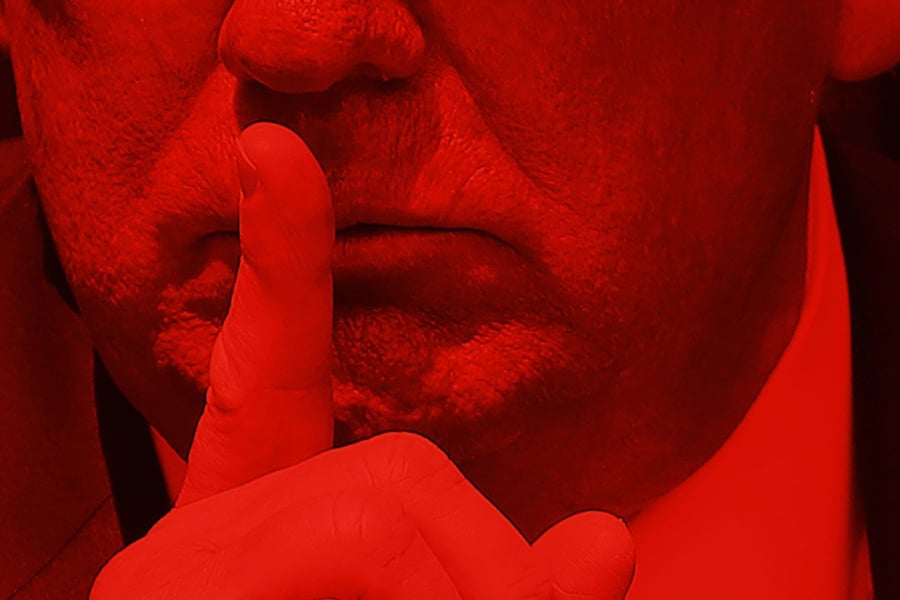They didn’t waste a day.
In the aftermath of conservative podcaster Charlie Kirk’s assassination, Donald Trump’s government immediately got to work crafting its road map for cracking down on liberal groups and the president’s domestic foes. According to sources with direct knowledge of the matter, within 24 hours of the Kirk shooting, top Trump officials and administration lawyers — at the White House, Justice Department, and so forth — had already put pen to pad, drafting legal memos, writing blueprints for any number of possible executive actions, and prioritizing which liberal organizations and strongholds of the left needed targeting.
At the top of these frantic intradepartmental efforts sat Stephen Miller, the White House deputy chief of staff, who personally supplied several names for key targets, as he worked the phones with other government officials to stress to them that the administration was now “at war.”
Even for a government run by Trump, Miller, and all of the Project 2025 architects, the pace at which the administration got to work escalating its agenda for domestic political and legal warfare was intense. Two Trump administration officials describe pulling all-nighters following Kirk’s assassination, examining how to use existing anti-terrorism laws for the next fronts in Trump’s campaign of aggression on the American left. “For Charlie,” the officials would say to one another, as they worked after-hours, plotting the coming blitz, and gaming out scenarios, including likely court challenges to their actions.
Speaking with Vice President J.D. Vance on Kirk’s podcast on Sept. 15, days after his death, Miller intoned, “The last message that Charlie sent me … was that we needed to have an organized strategy to go after the left-wing organizations that are promoting violence in this country.” He continued, “With God as my witness, we are going to use every resource we have at the Department of Justice, Homeland Security, and throughout this government to identify, disrupt, dismantle, and destroy these networks.”
The memos and legal justifications leaned heavily on the infrastructure and the statutes left behind from George W. Bush’s Global War on Terror. Trump administration aides and attorneys talked among themselves about how the Kirk slaying made it clear they needed a new “war on terror,” in their words, but one launched and branded by Donald J. Trump, and aimed straight at the homegrown domestic enemies of MAGA world. It came at a moment when the administration was already throwing around the “terrorism” label widely as it tried to accomplish its most extreme goals, from blowing up boats of alleged drug smugglers in the Caribbean to revving up its militarized deportation operations.
In the earliest moments of Team Trump’s rapid-fire drafting process in mid-September 2025, administration officials say, names that kept coming up in the revenge-minded deliberations included: antifa, America’s disparate anti-fascist movement; the liberal-donation processor ActBlue; megadonor George Soros; the anti-Trump organizing group Indivisible; a variety of pro-immigration and Know Your Rights organizations; and the anti-war group CodePink, whose activists recently protested Trump at a restaurant. And, of course, administration officials couldn’t help themselves from brainstorming new ways to try to target the American trans community.
Love Music?
Get your daily dose of everything happening in Australian/New Zealand music and globally.
And yet, several of the president’s advisers tell Rolling Stone, something felt off, even to a few of the longtime, hardened denizens of Trump land. There were barely, if any, senior law enforcement personnel who believed that the suspect in the Kirk shooting had acted as part of a terror network or had conspired with any organization of the left. “That was never really on anyone’s radar to any serious degree,” says one senior administration official. But the rosters that emerged out of the administration of whom, or what, to destroy were little more than a laundry list of nonprofits, liberal institutions, donors, and nonviolent groups that Trump apparatchiks like Miller had wanted to obliterate for years.
“The horrific murder of Charlie Kirk gave someone like Mr. Trump, with all his vindictive pettiness and disregard for the law, the very opening he needed to kick a campaign of legal retribution into high gear,” says Bradley Moss, a longtime national-security lawyer whose firm represents people who’ve been targeted by the second Trump administration. “There arguably is no comparable point in the history of this country — not even when Americans fought each other during the Civil War — when the very constitutional framework has been so close to succumbing to the authoritarian whims of a single official.”
Within a few weeks, the Trump White House had issued an executive order, guidance, and a presidential memorandum targeting antifa and “domestic terrorism” supposedly linked to anti-fascism — or, in reality, activities relating to a variety of left-leaning causes. In Trump’s second term, it is now the default position of the federal government that any speech he and his minions do not appreciate can be classified as “pro-terrorism,” or material support for it.
The loud crackdown that Trump and his lieutenants began carrying out in the wake of Kirk’s death didn’t have all that much to do with, well, the death of the founder of the conservative activist group Turning Point USA. The Trump administration wasn’t writing new plans so much as ramping up its ongoing blitz to consolidate power, and to silence any and all dissent and scrutiny — from late-night comedians to liberal groups and activists to news outlets. Simply put, Trump and the GOP want scalps piled up — figuratively speaking, they insist — as quickly as possible.
“We need to use our anti-terrorism laws, our RICO statutes, our conspiracy statutes — we need to use every tool in our law enforcement arsenal to crush these left-wing terrorists legally, financially, and politically, and to cut off their funding sources, and throw them in prison,” Mike Davis, a conservative attorney close to Trump, tells Rolling Stone. “George Soros, and the octopus of his left-wing organizations, must be investigated. NGOs importing and harboring illegal aliens must be investigated. Nobody is above the law. I’m very excited for these Democrats to face criminal probes for their real crimes.… Justice is coming — and justice is best served cold.”
Since retaking power, Trump has worked every day to turn the presidency into a weapon against his enemies. He has tried to censor and silence journalists, activists, comedians, aging rock stars, and law firms. He has sought to jail and deport foreign students for their pro-Palestine speech. He has issued executive orders directing the Justice Department to investigate his political enemies, including one former Trump official who opposed Trump’s lies about the 2020 election. He’s issued an order calling for people to be prosecuted for burning the flag. He has led an all-out assault on the concepts of diversity, equity, and inclusion, and the very existence of transgender people.
As part of his mass-deportation campaign, Trump has turned Immigration and Customs Enforcement (ICE) agents into a masked, unaccountable secret police that kidnaps people off the streets, arrests them at court hearings, and seeks their deportation, including to dangerous countries to which they have no ties. The president has routinely deployed the military to Democratic-led cities to intimidate liberals and support his immigrant roundups. America’s democratically elected leader has shaken down Big Tech firms and news outlets to secure donations for his future presidential library. He used the Federal Communications Commission (FCC) to install a “bias monitor” at CBS News as a condition of its parent company’s merger.
Despite pretending as if he’s the anti-“cancel culture” leader of the party of “free speech,” Trump very much wants to shut down speech that annoys him. Multiple current and former aides to Trump recount being forced to watch live TV while sitting with him at the White House, on a plane, or elsewhere, and the president melting down in real time at something he heard about himself and declaring that those remarks were “illegal.”
It is against this backdrop that Trump, in the wake of Kirk’s murder, used the FCC to temporarily force comedian Jimmy Kimmel’s ABC late-night show off the air, as part of a wide-ranging, far-right clampdown.
Trump also publicly demanded that Attorney General Pam Bondi charge his political enemies with little basis; reportedly urged the Justice Department to investigate the foundations run by Soros, the liberal donor; signed an executive order designating antifa as a domestic terrorist organization; and issued a presidential memorandum directing the federal government to target “domestic terrorism,” which has become the president’s preferred description for liberal activism.
Speaking at Kirk’s memorial, Trump labored to connect his crackdown to Kirk’s death. The president claimed that “antifa terrorists,” “paid agitators,” and protesters had tried to obstruct the murdered podcaster’s work. He indicated the Justice Department would investigate the “bad people.”
“But law enforcement can only be the beginning of our response to Charlie’s murder,” Trump said, pointing to “stories of commentators, influencers, and others in our society who greeted his assassination with sick approval, excuses, or even jubilation.”
MAGA activists had been furiously compiling social media posts from liberals and leftists who criticized Kirk after his death — doxing them, contacting their employers, demanding they lose their jobs and livelihoods. Vice President Vance endorsed this campaign while hosting Kirk’s podcast. “When you see someone celebrating Charlie’s murder, call them out, and, hell, call their employer,” he said.
When he spoke at Kirk’s memorial, Trump was confident he’d secured one of his most coveted scalps — Jimmy Kimmel’s — and bragged to the crowd about how liberals were “screaming fascism” over it.
Kimmel’s late-night show had been knocked off the air, after conservatives freaked out over comments he made in the wake of Kirk’s killing. Amid the right-wing outrage campaign, Trump’s FCC chair, Brendan Carr, threatened to revoke broadcasters’ licenses if they continued airing Kimmel’s show, telling the companies, “We can do this the easy way or the hard way.”
In the hours after those words left the Trump’s FCC henchman’s lips, there was a frantic spree of senior-level emergency meetings held at ABC, parent company Disney, and the broadcasting companies to determine how to handle the situation, contain the level of damage, and avoid Trump’s wrath, according to sources close to the situation.
According to network and Disney insiders and other sources with knowledge of the matter, several executives involved with the decision-making admitted behind closed doors that they didn’t think Kimmel said anything offensive or wrong. But the people in charge were “pissing themselves all day” about what the Trump administration could do to them and their bottom line, as one ABC insider put it — even though ABC agreed late last year to donate $15 million to Trump’s library fund to settle a lawsuit no one expected the president to actually win.
ABC and broadcast giants Sinclair and Nexstar, which are all regulated by Trump’s FCC, quickly folded. Kimmel was bumped off the air. Trump’s long-desired war on late night was working.
Reflecting on how these companies and others so quickly caved to Trump, Tufts University political science professor Matthew Segal says that “very sophisticated people” appear to be betting that “the rule of law is crumbling,” calling it “extremely worrying.”
In Kimmel’s case, the story didn’t end there. Consumers moved to boycott Disney and 1.7 million users reportedly canceled their paid subscriptions to Disney+, Hulu, and ESPN within a week. Celebrities, actors, and filmmakers spoke out against ABC, and Disney’s decision to succumb to Trump’s war on speech. Within days, ABC restarted Kimmel’s show — and Sinclair and Nexstar soon relented, too.
Within the upper ranks of the Trump administration, aides drafted face-saving talking points, according to people involved with writing them, taking the posture that Trump’s FCC hadn’t actually threatened broadcasters’ licenses to get Kimmel off the air — despite this happening on camera. Administration officials knew the companies had received intense pushback, and preferred to minimize the public perception that Trump was trying to impose a far-reaching censorship regime. Vance and Carr towed this line, arguing that the Kimmel show’s suspension was nothing more than an independent business decision by ABC, Nexstar, and Sinclair.
Trump, however, couldn’t help himself — and quickly lashed out over the news about Kimmel’s return. “I can’t believe ABC Fake News gave Jimmy Kimmel his job back. The White House was told by ABC that his Show was canceled!” he wrote, issuing vague, new threats. “We’re going to test ABC out on this. Let’s see how we do. Last time I went after them, they gave me $16 Million Dollars.”
The president may have taken Disney’s Kimmel reversal hard — but he’s continued to use Kirk’s murder to ramp up his attacks on his political enemies and the vulnerable.
Trump recently signed a “national security presidential memorandum” that claimed various liberal viewpoints were “animating … violent conduct.” The memo issues a sweeping call for federal prosecutions, while teeing up further attacks on trans people.
“There are common recurrent motivations … uniting this pattern of violent and terroristic activities under the umbrella of self-described ‘anti-fascism,’” reads the memo. “This ‘anti-fascist’ lie has become the organizing rallying cry used by domestic terrorists to wage a violent assault against democratic institutions, constitutional rights, and fundamental American liberties.” It continues: “Common threads animating this violent conduct include anti-Americanism, anti-capitalism, and anti-Christianity; support for the overthrow of the United States government; extremism on migration, race, and gender; and hostility towards those who hold traditional American views on family, religion, and morality.”
Trump’s directive commands the government to “investigate, prosecute, and disrupt entities and individuals engaged in acts of political violence and intimidation designed to suppress lawful political activity or obstruct the rule of law.”
“At the president’s direction, the Trump administration will get to the bottom of this vast network inciting violence in American communities, and the president’s executive actions to address left-wing violence will put an end to any illegal activities,” White House spokesperson Abigail Jackson tells Rolling Stone.
The proclamations about “domestic terrorism” came amid reports that Trump’s administration is seeking to investigate George Soros’ donor network.
According to The New York Times, a top Trump official at the Justice Department wants to base the investigation off of a sensationalist report from the conservative Capital Research Center, which claims that Soros’ network has “poured over $80 million into groups tied to terrorism or extremist violence.” The document uses variations of the word “terror” 405 times; like the Trump administration, it throws this word around as if that makes matters open and shut.
Soros’ network, in response, called out Trump’s “politically motivated attacks on civil society, meant to silence speech the administration disagrees with and undermine the First Amendment.”
One progressive nonprofit leader tells Rolling Stone they hope organizations ignore Trump’s attacks: “Unless there’s a legal request, a lawful request, to do something or produce anything, why should we respond?”
Trump and his ilk would like to see criminal charges, trials, and convictions. While some of his advisers concede that these cases may well fail, one benefit to their multi-pronged “war on terror”-style crusade is that the approach could force their enemies to lawyer up, bleed money or lose funding, and crouch in a defensive posture. “Regardless, they need to suffer,” says a senior Trump official involved with the planning of the blitz.
The hope, Trump advisers say, is that the pervasive drumbeat of propaganda and fear has a vast, chilling effect — on their political enemies, on major institutions of American liberalism, on left-leaning speech — even if judges end up tossing out many of their cases.
Trump appears to just be getting started with his attacks on his political opponents. He recently demanded on social media that Attorney General Bondi move to quickly charge his enemies, including former FBI Director James Comey, Sen. Adam Schiff, and New York Attorney General Letitia James, who led the state civil fraud trial against Trump’s business empire. Trump specifically demanded the firing of Erik Siebert, Trump’s handpicked U.S. attorney in Virginia who declined to charge the New York AG.
When President Trump wrote his directive to “Pam” on Truth Social, demanding the prosecutions, numerous officials in the Justice Department and White House were blindsided, and confused about whether or not the president meant to put that directive on the internet for the whole country to see. The way it was written led several senior Trump administration officials to quickly conclude that he had meant to send Bondi a private message, but had accidentally posted it online, sources with direct knowledge of the situation tell Rolling Stone. Nevertheless, everyone went with it: Trump and his team decided to play it off like the post was meant for public consumption the whole time.
Yet, in an administration stacked to the brim with MAGA sycophants, Trump’s decision to axe Siebert and swap in one of his former personal attorneys, Lindsey Halligan, was met not with enthusiasm but with resignation. Bondi, as well as her deputy (another recent Trump lawyer) Todd Blanche, had privately urged Trump and the White House to keep Siebert in place. It didn’t matter that he had a solid reputation in conservative legal circles. He wasn’t prosecuting or jailing people who pissed off Trump. So, he had to go.
Still, there’s something else bothering Team Trump about all of this. In early 2017, legal writer Ben Wittes used the phrase “malevolence tempered by incompetence” to describe the opening salvo of Trump’s first administration. Despite the severe damage being inflicted, it is possible that a similar fate will befall Trump’s smash-and-grab-style operation to jail his opponents in 2025.
In the days after Trump’s post to “Pam” that Saturday, several senior Trump administration officials independently told Rolling Stone that they were worried the president was making it harder for them to succeed. With his likely accidental social media post, Trump had announced to the world his rendition of “show me the man, and I’ll show you the crime.”
Multiple Trump appointees privately concede that if they were a defense attorney for any of Trump’s targets mentioned in that Truth Social post, the president’s own words would be the first thing they’d bring up in court. It is extremely difficult to win a motion to dismiss based on claims of selective or vindictive prosecution by the state. However, as one senior Trump official notes, “It’s like the president is holding up a sign saying, ‘This is selective prosecution,’ and then asking a judge to read the sign.”
Days after her appointment, Halligan got a grand jury to indict Comey, one of Trump’s desired targets.
For those who want to fight back against this onslaught, there are tactics that work. “There is a recognized playbook for confronting authoritarianism,” says progressive political strategist Anat Shenker-Osorio. “I boil it down to three R’s. It’s resistance, refusal, and ridicule,” she says. Resistance means stuff like marches, protests, social media posts. “Refusal is a higher bar. Refusal is when people just won’t do it,” Shenker-Osorio says, noting that the Disney boycott qualifies to some extent. “Ridicule is self-explanatory, right?” she continues. “And it’s part of the reason why comedians are always in the line of fire — because for the strongman to retain his image, he can’t conscience ridicule.”
Donald Trump’s revanchist approach was always the plan — not because Charlie Kirk was shot, but simply because Trump won reelection late last year.
In early January, not long before Trump was sworn into office for a second time, celebrity lawyer and self-described liberal Alan Dershowitz traveled to Florida to speak at a documentary screening held at the president-elect’s luxury resort and home of Mar-a-Lago. Since Trump’s first term, the Harvard Law figure and longtime Democrat has been one of Trump’s most ardent defenders from what he dubbed “lawfare.”
As Dershowitz delivered his remarks to the audience, the attorney noticed that Trump was in attendance, listening to his speech. In that moment, Dershowitz — who broadly agreed with Trump’s conspiratorial claims that the Justice Department had been “weaponized” against him and his advisers during the Biden years — felt compelled to directly address Trump, as if to appeal to whatever sense of mercy remained in his heart.
“I said I was opposed to any kind of weaponization of the legal system … and I was hoping the new administration would end any kind of lawfare,” Dershowitz tells Rolling Stone. “The proper response to what happened to you, I said, was not to do it to Democrats, it is to not do it to anybody.… Both parties should eschew weaponization.”
He says he saw Trump — just days away from reclaiming the powers of the presidency — seeming “to nod in agreement.”
Less than a year later, it’s clear that Donald Trump did not agree. And the entire country is now paying for it.
From Rolling Stone US



































